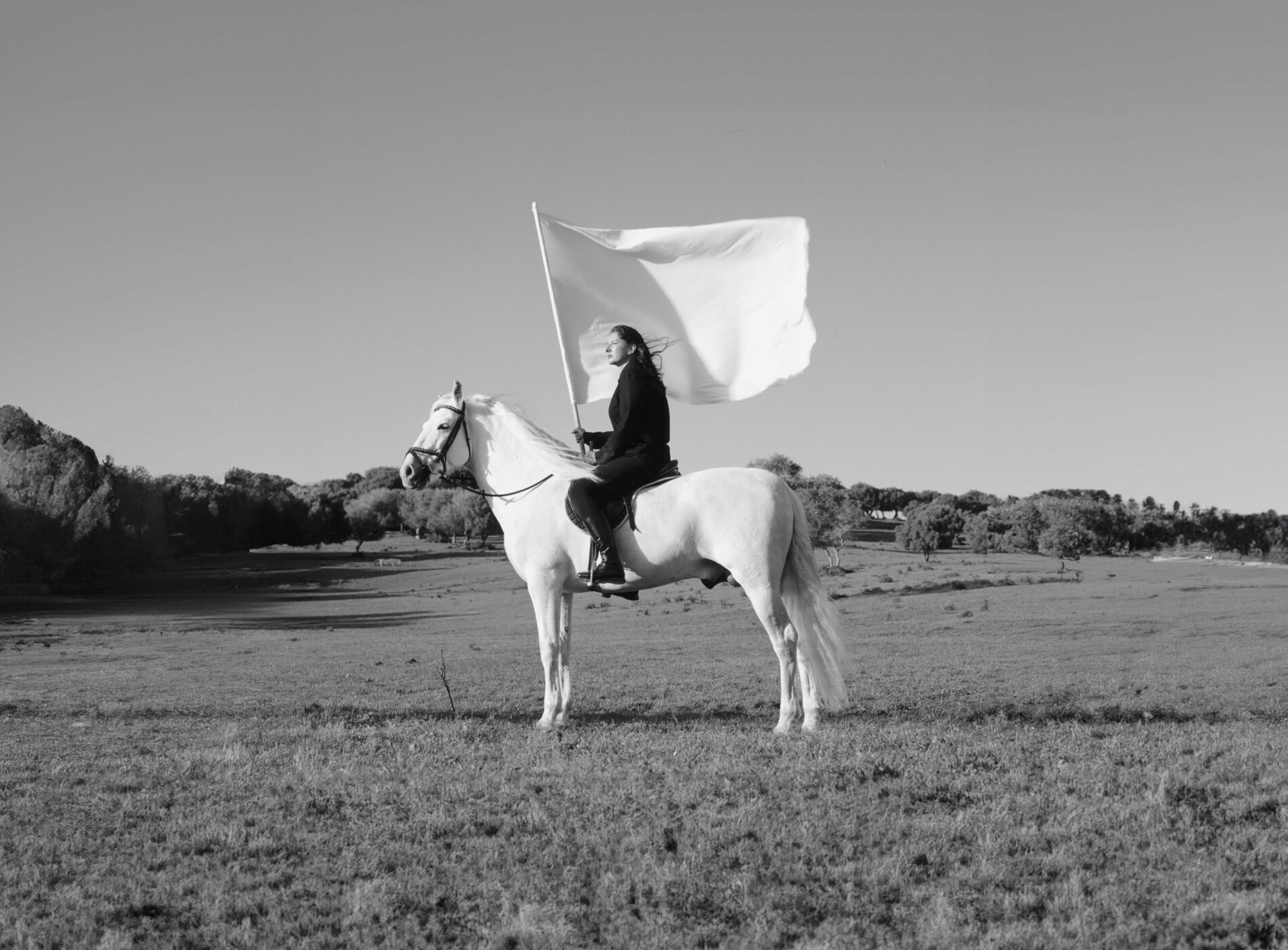

COLUMN: MUSIC
I Think It's Kicking In
It’s a bit of a Chinese Finger Trap, this column. Consider the toy’s tight constraint around your wee fingers, the desire to be free is obvious, but the charm of its embrace? Well, it hurts so good. Now consider, halfway through minute four, one of many youthful subjects in Maud Geffray’s gauzy, dreamy short film,
_1994_
. Eyes alive, limbs loose, laced with a contagious groove absorbed from the surrounding cut-loose. The movement is molecular.
Deep trance is what propels Geffray’s pre-millennial documentary of an outdoor rave that took place on a desolate beach in Brittany in August of the eponymous year. What’s so beautifully stirring about the film and its treatment is that despite the niche nature of the happening—one of the earliest of its kind for this region of France—is the universally accessible nature of celebratory release, of that longing for more, despite its temporality, its exhaustive nature. Upon Geffray’s showing of the final piece to her parents, they remarked, “Wow, I was so emotional, I felt so many things.”
Many things are surely felt at summer camp, not the least of which is an inability to describe its culture to those who didn’t board the bus. “Nowadays, in 2015, everything is more common,” explains Geffray over the phone, along with her music partner, Sebastien Chenut \[the duo operate electronic outfit, Scratch Massive\] about the journey we’ve made from Brittany. “In the beginning, there was nothing. It was just different. But the idea of participation is still just as important.”
And so, the assembly gives rise to the good, the bad, and the ugly. Fraught with self-prophecy, it’s inevitable that these assemblies will eventually face their demise, become something different. Still, we chase that feeling, stubborn at its loss. “It was always something hot and sexy when you think about summer camp in America, no?” remarks Chenut, when considering the ideal versus actuality. “It was a chance to break the rules.”
So, we’ll continue our conversation with Geffray and Chenut, alongside an examination of summer camps that have to some end, broken the rules, gone off the rails, become something else. Consider The Freemasons—throughout their tenure as the pre-eminent conspiracy-theorist fodder—have periodically holed up in abandoned properties. In one particular site just North of New York’s municipal fringe, a Mason of the 32nd degree had taken up residence in an old sleep away camp. Maintaining only the principal edifice, this individual of the second-highest rank painted the walls a brilliant red and installed a large marble cross while the remainder of Camp Wishe descended into ruin. As Chenut remarks on the unique location of _1994_, “At the time, it was very far from where we were. No one knew we were there.
He continues about the formative nature of illegal or atypical music happenings of the era. “Well, at the beginning, when it was your first one, you went to some club with your friends, but it wasn’t like a job or a future.” Column keeping, this begs consideration of those for whom their identity was not a choice. Not anomalous throughout Europe’s fractious first half of the twentieth century, youth camps were formed to establish the next generation of any given dictatorial persuasion. Sites such as that of Colonia Fara in the seaside township of Chiavari, Italy, were once home to young groups of “happy little fascists” ripe for a Mussolini-style indoctrination. Still not subject to demolition or renovation, the shadow of the notorious Italian leader’s rule remains cast on beach-going holidaymakers to this very day, an eerie concrete phallus of former rigeur.
Still ruled by the phallus, Evangelical Christian camps are no longer unfamiliar to the mainstream since the 2006 release of Jesus Camp, which exposed Becky Fisher—the camp leader—as an extremist military-like commander. The Kids on Fire School of Ministry alumni are surely the product of sectarian extremism, and perhaps a little time spent with _1994_ might offer some degree of repair. “I think it’s about pain and that feeling.” Chenut remarks, considering the grip on the youth evident in the tribe of Breton ravers.
“If you were to recreate that nowadays,” Geffray says when asked about its possibility, “It could take place in a lot of different locations, but everything has to be really natural.” It might also help to have a boatload of top-of-the-line designer drugs. Consider Wisconsin’s Camp Wandawega, where the walls tell tales of alcohol swilling, one-night stands, and various other forbidden hijinks that were taboo during its Prohibition-era run. And still, we long for it. The camp has succeeded for decades in drawing nearby Chicagoans time and time again (under various guises), graduating to its current state as a comely location for glamping and trendy weddings.
Chenut and Geffray acknowledge the state of euphoria in some of the film’s subjects obviously owing to drug use, but they suggest beyond that, the release speaks to something more distilled. “It has to do with the feelings between people. It has to be something really simple and natural,” Geffray says. It’s built on music after all. And so we consider the Shaker community, who for all their work ethic, communalism, and ecstatic approach to worship, loved to get-the-fuck-down. In a calculated decision on the part of savvy musicians to reintroduce folk music in the 1950s, one shrewd initiative emerged to target summer camps and resorts; there was no better fodder for such a wholesome revival than a Shaker Village Work Group where a man named Tony Saleton, both folk singer and activist, was working. It was Saleton who taught Mr. Peter Seeger his revised version of “Michael Row the Boat Ashore” that would be sung around the campfire at night.
We may grow and flitter and collapse into other forms, we may be forced to rise and serve, but it’s the nearness of each other in so doing, it’s the fire in the pit that transfixes, it’s the rhythm and the bass, that makes this inexorable tugging, an act of endearment, an act of grace.
Still from _1994_, (2014). 9:26 Minutes. 8MM. Courtesy Maude Geffray.
Written by Madison Saxton-Beer
 
COLUMN: MUSIC
I Think It's Kicking In
It’s a bit of a Chinese Finger Trap, this column. Consider the toy’s tight constraint around your wee fingers, the desire to be free is obvious, but the charm of its embrace? Well, it hurts so good. Now consider, halfway through minute four, one of many youthful subjects in Maud Geffray’s gauzy, dreamy short film,
_1994_
. Eyes alive, limbs loose, laced with a contagious groove absorbed from the surrounding cut-loose. The movement is molecular.
Deep trance is what propels Geffray’s pre-millennial documentary of an outdoor rave that took place on a desolate beach in Brittany in August of the eponymous year. What’s so beautifully stirring about the film and its treatment is that despite the niche nature of the happening—one of the earliest of its kind for this region of France—is the universally accessible nature of celebratory release, of that longing for more, despite its temporality, its exhaustive nature. Upon Geffray’s showing of the final piece to her parents, they remarked, “Wow, I was so emotional, I felt so many things.”
Many things are surely felt at summer camp, not the least of which is an inability to describe its culture to those who didn’t board the bus. “Nowadays, in 2015, everything is more common,” explains Geffray over the phone, along with her music partner, Sebastien Chenut \[the duo operate electronic outfit, Scratch Massive\] about the journey we’ve made from Brittany. “In the beginning, there was nothing. It was just different. But the idea of participation is still just as important.”
And so, the assembly gives rise to the good, the bad, and the ugly. Fraught with self-prophecy, it’s inevitable that these assemblies will eventually face their demise, become something different. Still, we chase that feeling, stubborn at its loss. “It was always something hot and sexy when you think about summer camp in America, no?” remarks Chenut, when considering the ideal versus actuality. “It was a chance to break the rules.”
So, we’ll continue our conversation with Geffray and Chenut, alongside an examination of summer camps that have to some end, broken the rules, gone off the rails, become something else. Consider The Freemasons—throughout their tenure as the pre-eminent conspiracy-theorist fodder—have periodically holed up in abandoned properties. In one particular site just North of New York’s municipal fringe, a Mason of the 32nd degree had taken up residence in an old sleep away camp. Maintaining only the principal edifice, this individual of the second-highest rank painted the walls a brilliant red and installed a large marble cross while the remainder of Camp Wishe descended into ruin. As Chenut remarks on the unique location of _1994_, “At the time, it was very far from where we were. No one knew we were there.
He continues about the formative nature of illegal or atypical music happenings of the era. “Well, at the beginning, when it was your first one, you went to some club with your friends, but it wasn’t like a job or a future.” Column keeping, this begs consideration of those for whom their identity was not a choice. Not anomalous throughout Europe’s fractious first half of the twentieth century, youth camps were formed to establish the next generation of any given dictatorial persuasion. Sites such as that of Colonia Fara in the seaside township of Chiavari, Italy, were once home to young groups of “happy little fascists” ripe for a Mussolini-style indoctrination. Still not subject to demolition or renovation, the shadow of the notorious Italian leader’s rule remains cast on beach-going holidaymakers to this very day, an eerie concrete phallus of former rigeur.
Still ruled by the phallus, Evangelical Christian camps are no longer unfamiliar to the mainstream since the 2006 release of Jesus Camp, which exposed Becky Fisher—the camp leader—as an extremist military-like commander. The Kids on Fire School of Ministry alumni are surely the product of sectarian extremism, and perhaps a little time spent with _1994_ might offer some degree of repair. “I think it’s about pain and that feeling.” Chenut remarks, considering the grip on the youth evident in the tribe of Breton ravers.
“If you were to recreate that nowadays,” Geffray says when asked about its possibility, “It could take place in a lot of different locations, but everything has to be really natural.” It might also help to have a boatload of top-of-the-line designer drugs. Consider Wisconsin’s Camp Wandawega, where the walls tell tales of alcohol swilling, one-night stands, and various other forbidden hijinks that were taboo during its Prohibition-era run. And still, we long for it. The camp has succeeded for decades in drawing nearby Chicagoans time and time again (under various guises), graduating to its current state as a comely location for glamping and trendy weddings.
Chenut and Geffray acknowledge the state of euphoria in some of the film’s subjects obviously owing to drug use, but they suggest beyond that, the release speaks to something more distilled. “It has to do with the feelings between people. It has to be something really simple and natural,” Geffray says. It’s built on music after all. And so we consider the Shaker community, who for all their work ethic, communalism, and ecstatic approach to worship, loved to get-the-fuck-down. In a calculated decision on the part of savvy musicians to reintroduce folk music in the 1950s, one shrewd initiative emerged to target summer camps and resorts; there was no better fodder for such a wholesome revival than a Shaker Village Work Group where a man named Tony Saleton, both folk singer and activist, was working. It was Saleton who taught Mr. Peter Seeger his revised version of “Michael Row the Boat Ashore” that would be sung around the campfire at night.
We may grow and flitter and collapse into other forms, we may be forced to rise and serve, but it’s the nearness of each other in so doing, it’s the fire in the pit that transfixes, it’s the rhythm and the bass, that makes this inexorable tugging, an act of endearment, an act of grace.
Still from _1994_, (2014). 9:26 Minutes. 8MM. Courtesy Maude Geffray.
Written by Madison Saxton-Beer

COLUMN: MUSIC
I Think It's Kicking In
It’s a bit of a Chinese Finger Trap, this column. Consider the toy’s tight constraint around your wee fingers, the desire to be free is obvious, but the charm of its embrace? Well, it hurts so good. Now consider, halfway through minute four, one of many youthful subjects in Maud Geffray’s gauzy, dreamy short film,
_1994_
. Eyes alive, limbs loose, laced with a contagious groove absorbed from the surrounding cut-loose. The movement is molecular.
Deep trance is what propels Geffray’s pre-millennial documentary of an outdoor rave that took place on a desolate beach in Brittany in August of the eponymous year. What’s so beautifully stirring about the film and its treatment is that despite the niche nature of the happening—one of the earliest of its kind for this region of France—is the universally accessible nature of celebratory release, of that longing for more, despite its temporality, its exhaustive nature. Upon Geffray’s showing of the final piece to her parents, they remarked, “Wow, I was so emotional, I felt so many things.”
Many things are surely felt at summer camp, not the least of which is an inability to describe its culture to those who didn’t board the bus. “Nowadays, in 2015, everything is more common,” explains Geffray over the phone, along with her music partner, Sebastien Chenut \[the duo operate electronic outfit, Scratch Massive\] about the journey we’ve made from Brittany. “In the beginning, there was nothing. It was just different. But the idea of participation is still just as important.”
And so, the assembly gives rise to the good, the bad, and the ugly. Fraught with self-prophecy, it’s inevitable that these assemblies will eventually face their demise, become something different. Still, we chase that feeling, stubborn at its loss. “It was always something hot and sexy when you think about summer camp in America, no?” remarks Chenut, when considering the ideal versus actuality. “It was a chance to break the rules.”
So, we’ll continue our conversation with Geffray and Chenut, alongside an examination of summer camps that have to some end, broken the rules, gone off the rails, become something else. Consider The Freemasons—throughout their tenure as the pre-eminent conspiracy-theorist fodder—have periodically holed up in abandoned properties. In one particular site just North of New York’s municipal fringe, a Mason of the 32nd degree had taken up residence in an old sleep away camp. Maintaining only the principal edifice, this individual of the second-highest rank painted the walls a brilliant red and installed a large marble cross while the remainder of Camp Wishe descended into ruin. As Chenut remarks on the unique location of _1994_, “At the time, it was very far from where we were. No one knew we were there.
He continues about the formative nature of illegal or atypical music happenings of the era. “Well, at the beginning, when it was your first one, you went to some club with your friends, but it wasn’t like a job or a future.” Column keeping, this begs consideration of those for whom their identity was not a choice. Not anomalous throughout Europe’s fractious first half of the twentieth century, youth camps were formed to establish the next generation of any given dictatorial persuasion. Sites such as that of Colonia Fara in the seaside township of Chiavari, Italy, were once home to young groups of “happy little fascists” ripe for a Mussolini-style indoctrination. Still not subject to demolition or renovation, the shadow of the notorious Italian leader’s rule remains cast on beach-going holidaymakers to this very day, an eerie concrete phallus of former rigeur.
Still ruled by the phallus, Evangelical Christian camps are no longer unfamiliar to the mainstream since the 2006 release of Jesus Camp, which exposed Becky Fisher—the camp leader—as an extremist military-like commander. The Kids on Fire School of Ministry alumni are surely the product of sectarian extremism, and perhaps a little time spent with _1994_ might offer some degree of repair. “I think it’s about pain and that feeling.” Chenut remarks, considering the grip on the youth evident in the tribe of Breton ravers.
“If you were to recreate that nowadays,” Geffray says when asked about its possibility, “It could take place in a lot of different locations, but everything has to be really natural.” It might also help to have a boatload of top-of-the-line designer drugs. Consider Wisconsin’s Camp Wandawega, where the walls tell tales of alcohol swilling, one-night stands, and various other forbidden hijinks that were taboo during its Prohibition-era run. And still, we long for it. The camp has succeeded for decades in drawing nearby Chicagoans time and time again (under various guises), graduating to its current state as a comely location for glamping and trendy weddings.
Chenut and Geffray acknowledge the state of euphoria in some of the film’s subjects obviously owing to drug use, but they suggest beyond that, the release speaks to something more distilled. “It has to do with the feelings between people. It has to be something really simple and natural,” Geffray says. It’s built on music after all. And so we consider the Shaker community, who for all their work ethic, communalism, and ecstatic approach to worship, loved to get-the-fuck-down. In a calculated decision on the part of savvy musicians to reintroduce folk music in the 1950s, one shrewd initiative emerged to target summer camps and resorts; there was no better fodder for such a wholesome revival than a Shaker Village Work Group where a man named Tony Saleton, both folk singer and activist, was working. It was Saleton who taught Mr. Peter Seeger his revised version of “Michael Row the Boat Ashore” that would be sung around the campfire at night.
We may grow and flitter and collapse into other forms, we may be forced to rise and serve, but it’s the nearness of each other in so doing, it’s the fire in the pit that transfixes, it’s the rhythm and the bass, that makes this inexorable tugging, an act of endearment, an act of grace.
Still from _1994_, (2014). 9:26 Minutes. 8MM. Courtesy Maude Geffray.
Written by Madison Saxton-Beer









.JPG)
.jpg)







